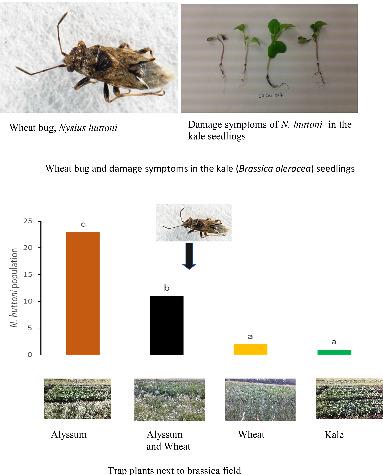当前位置:
X-MOL 学术
›
Agric. For. Entomol.
›
论文详情
Our official English website, www.x-mol.net, welcomes your
feedback! (Note: you will need to create a separate account there.)
Evaluation of potential trap plant species for the wheat bug Nysius huttoni (Hemiptera: Lygaeidae) in forage brassicas
Agricultural and Forest Entomology ( IF 1.6 ) Pub Date : 2020-04-30 , DOI: 10.1111/afe.12379 Sundar Tiwari 1 , David J. Saville 1, 2 , Sheela Sharma 3 , Morgan W. Shields 1 , Stephen D. Wratten 1
Agricultural and Forest Entomology ( IF 1.6 ) Pub Date : 2020-04-30 , DOI: 10.1111/afe.12379 Sundar Tiwari 1 , David J. Saville 1, 2 , Sheela Sharma 3 , Morgan W. Shields 1 , Stephen D. Wratten 1
Affiliation

|
The wheat bug Nysius huttoni is a major pest of brassica seedlings. Management of this insect currently relies on seed treatment with neonicotinoids and spraying with chlorpyrifos and pyrethroid insecticides. These practices can generate severe external costs, including human health, the environment and biodiversity. Trap cropping is one alternative option to protect brassica seedlings from N. huttoni. Trap crop species evaluated in field cage experiments were: alyssum (Lobularia maritima L. Desvauxcv. Benthamii White), wheat (Triticum aestivum L. cv. Morph), coriander (Coriandrum sativum L. cv. Santo) and clover (Trifolium repens L. cv. Nomad). These were compared with kale (Brassica oleracea L. cv. Kestrel). In open‐field experiments, alyssum (L maritima), wheat (T. aestivum) and a mixture of alyssum (L. maritima) and wheat (T. aestivum) were used. All of these were compared to kale (B. oleracea). Alyssum and wheat were the most favoured potential trap plants for N. huttoni. Results indicated that two treatments: alyssum (used as a single trap crop) or ‘alyssum plus wheat’ (a multiple trap crop), may be useful in brassica fields to protect the seedlings from N. huttoni damage. Such a trap cropping protocol potentially reduces pesticide use in forage brassicas and can also deliver multiple ecosystem services such as biological control of insect pests.
中文翻译:

评价牧草芸苔中小麦虫 Nysius huttoni(半翅目:Lygaeidae)的潜在诱捕植物物种
小麦虫 Nysius huttoni 是芸苔属幼苗的主要害虫。这种昆虫的管理目前依赖于用新烟碱类药物处理种子以及喷洒毒死蜱和拟除虫菊酯杀虫剂。这些做法会产生严重的外部成本,包括人类健康、环境和生物多样性。陷阱种植是保护芸苔幼苗免受 N. huttoni 侵害的一种替代选择。在田间网箱试验中评估的诱捕作物种类有:香椿(Lobularia maritima L. Desvauxcv. Benthamii White)、小麦(Triticum aestivum L. cv. Morph)、香菜(Coriandrum sativum L. cv. Santo)和三叶草(Trifolium repens L.简历。游牧)。这些与羽衣甘蓝(Brassica oleracea L. cv. Kestrel)进行了比较。在露地试验中,天竺葵 (L. maritima)、小麦 (T. aestivum) 以及天竺葵 (L. maritima) 和小麦 (T. aestivum) 被使用。所有这些都与羽衣甘蓝(B. oleracea)进行了比较。Alyssum 和小麦是最受 N. huttoni 青睐的潜在诱捕植物。结果表明,两种处理方法:海盐(用作单一诱捕作物)或“海盐加小麦”(多重诱捕作物),可能在芸苔田中保护幼苗免受 N. huttoni 损害。这种诱捕种植协议可能会减少牧草芸苔中农药的使用,还可以提供多种生态系统服务,例如昆虫害虫的生物防治。胡托尼损坏。这种诱捕种植协议可能会减少牧草芸苔中农药的使用,还可以提供多种生态系统服务,例如昆虫害虫的生物防治。胡托尼损坏。这种诱捕种植协议可能会减少牧草芸苔中农药的使用,还可以提供多种生态系统服务,例如昆虫害虫的生物防治。
更新日期:2020-04-30
中文翻译:

评价牧草芸苔中小麦虫 Nysius huttoni(半翅目:Lygaeidae)的潜在诱捕植物物种
小麦虫 Nysius huttoni 是芸苔属幼苗的主要害虫。这种昆虫的管理目前依赖于用新烟碱类药物处理种子以及喷洒毒死蜱和拟除虫菊酯杀虫剂。这些做法会产生严重的外部成本,包括人类健康、环境和生物多样性。陷阱种植是保护芸苔幼苗免受 N. huttoni 侵害的一种替代选择。在田间网箱试验中评估的诱捕作物种类有:香椿(Lobularia maritima L. Desvauxcv. Benthamii White)、小麦(Triticum aestivum L. cv. Morph)、香菜(Coriandrum sativum L. cv. Santo)和三叶草(Trifolium repens L.简历。游牧)。这些与羽衣甘蓝(Brassica oleracea L. cv. Kestrel)进行了比较。在露地试验中,天竺葵 (L. maritima)、小麦 (T. aestivum) 以及天竺葵 (L. maritima) 和小麦 (T. aestivum) 被使用。所有这些都与羽衣甘蓝(B. oleracea)进行了比较。Alyssum 和小麦是最受 N. huttoni 青睐的潜在诱捕植物。结果表明,两种处理方法:海盐(用作单一诱捕作物)或“海盐加小麦”(多重诱捕作物),可能在芸苔田中保护幼苗免受 N. huttoni 损害。这种诱捕种植协议可能会减少牧草芸苔中农药的使用,还可以提供多种生态系统服务,例如昆虫害虫的生物防治。胡托尼损坏。这种诱捕种植协议可能会减少牧草芸苔中农药的使用,还可以提供多种生态系统服务,例如昆虫害虫的生物防治。胡托尼损坏。这种诱捕种植协议可能会减少牧草芸苔中农药的使用,还可以提供多种生态系统服务,例如昆虫害虫的生物防治。









































 京公网安备 11010802027423号
京公网安备 11010802027423号